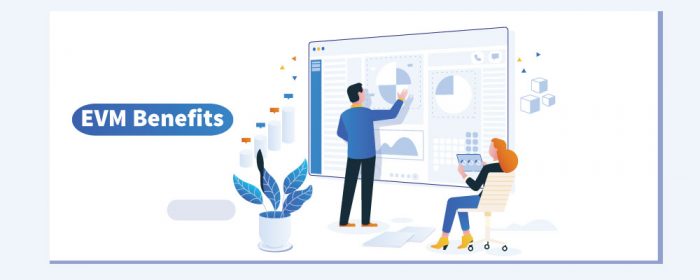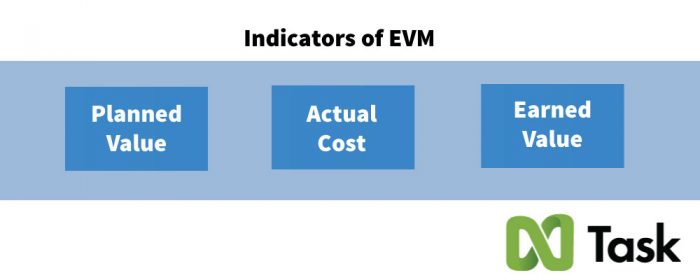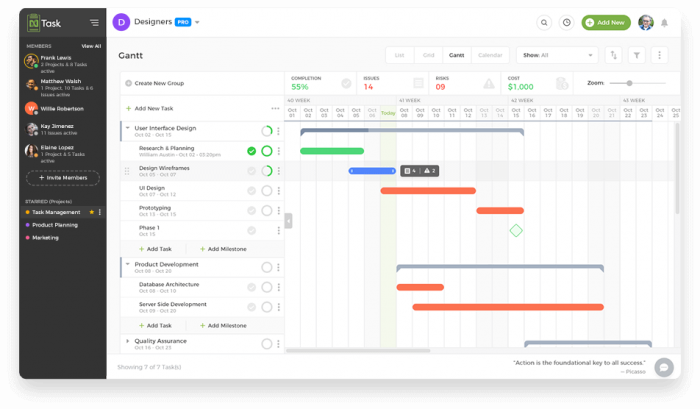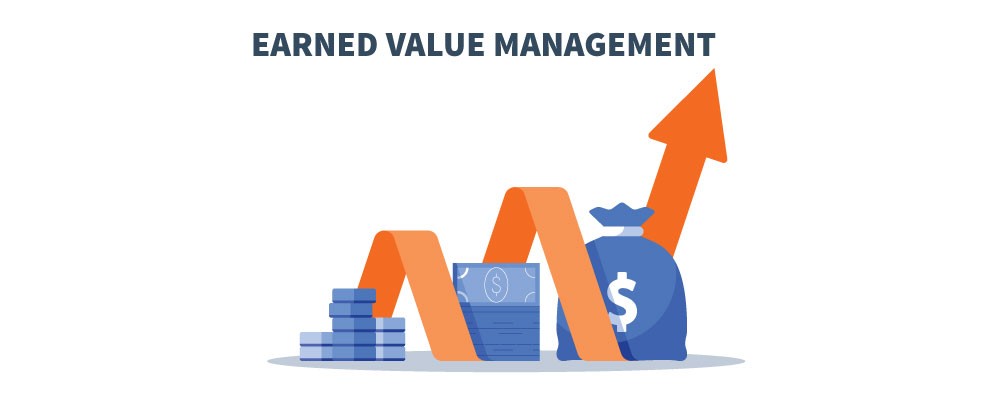As a project manager, one thing you want to ensure is that your project runs on schedule and within budget.
Straying off course is often disastrous for projects not only because of the project delays and added costs but also due to the risk of a complete project failure.
Project management disciplines can help.
Earned Value Management is one such discipline.
If you are wondering what earned value management is, what it entails, the calculations and terminologies involved you have come to the right place.
In this blog post, we will go over all the basics of earned value management.
So, let’s get right to it!
What is Earned Value Management?
Earned Value Management of EVM is a type of project management approach that provides all levels of management.
This management approach allows you and your team to gain early visibility, especially in regard to schedule and cost-related issues.
EVM integrates costs, schedule, and scope to allow you to measure project performance. With calculations based on your planned values versus actual values, EVM can allow you to predict outcomes and be prepared.
You can thus track your project’s performance against project baselines.
There are three terms associated with EVM and in order to fully understand this project management approach you need to be aware of all three.
These three terms are: earned value management, earned value management systems, and earned value analysis.
The first is what this blog post will be focusing on which is Earned Value management. EVM is a methodology that measures project performance and is often based on the project’s work breakdown structure. To learn more about the work breakdown structure check out our blog post here.
Secondly, is the Earned Value Management System or EVMS which is the group of processes, procedures, tools, and templates that help achieve EVM and organize EVM.
Finally, there is Earned Value Analysis or EVA which is a quantitative project management technique. EVA measures project performance by predicting likely project results. You achieve these predictions by the comparison of progress and budget of work planned against that of actual costs.
Benefits of Using Earned Value Management

EVM may seem complicated and a bit confusing at first but we are sure after reading this blog post things will start to make more sense.
However, before we get into how EVM works, the terminology and calculations used it is beneficial to know what benefits you can gain from adopting EVM.
Here are just some of the benefits of this project management methodology.
EVM has a powerful predictive capability thus making it a great project cost control measure.
This methodology provides more in-depth information than simple project tracking thus giving you a range of other advantages as well.
Some of the things you can gain from EVM include the following:
- EVM enables you to map work with costs. This in turn reduces unclarity into quantifiable factors.
- EVM helps to prevent scope creep.
- EVM helps reduce risks by enabling you to intervene ahead of time and quickly.
- You can also more easily identify critical paths and compare your project’s current status with the project baseline.
- You improve your visibility which can aid in communication with stakeholders and create accountability through clear metrics.
- With EVM you gain greater insight in terms of the big picture for both your project as well as on a portfolio level.
- EVM provides better accountability, performance tracking, and project forecasting.
Featured Readings:
Indicators in Earned Value Management

EVM can be quite intimidating due to the range of calculations and terminologies used. We have broken down the terminologies to help you understand what each means.
We will then go on to some of the calculations you’ll need and formulas you can follow.
- Planned Value (PV) is also referred to as Budgeted Cost for Work Scheduled (BCWS). This is the money you budgeted to accomplish the work or tasks that were scheduled. This value varies depending on the scope of work that you are considering and where in your project you are in terms of the overall schedule.
- Actual Cost (AC) is also known as Actual Cost of Work Performed (ACWP). This is the actual amount spent on accomplished work.
- Earned Value (EV) is sometimes referred to as Budgeted Cost for Work Performed (BCWP). This is the percentage of the whole project budget that has been used at any point in time.
These three numbers are important to help calculate variance analysis. That is to say, when you want to know how far off you were from the project baseline, you will make variance calculations.
This is determined through both schedule and cost variance.
- Schedule Variance (SV) is a quantitative indicator. SV highlights how far off you were from the initial planned schedule. You can determine if you were behind or ahead of schedule depending on whether the value is negative or positive respectively. If you have a value of 0 this means that you are exactly on schedule.
- Cost Variance (CV) is also a quantitative indicator. CV highlights how far off you were from the initial planned budget. You can determine if you were over or under budget depending on whether the value is negative or positive respectively. If you have a value of 0 this means that you are exactly within budget.
You can also determine project performance apart from variance through performance indexes. In EVM you have two indexes, that is the schedule and cost index.
- Schedule Performance Index (SPI). SPI compares the progress of your project achieved against the expected progress. This expected progress is usually highlighted in the project charter. If the SPI is a number less than 1, this indicates that your project is behind schedule.
- Cost Performance Index (CPI). CPI measures the value of work completed in your project against that of the costs incurred. If the CPI is a number less than 1, this indicates that your project is over budget.
Earned Value Management Calculations
Here are some formulas to help with calculations for your EVM.
PV or BCWS. PV = total project cost * % of planned work.
AC or ACWP. AC is calculated by tracking the actual cost of the work done. Include hidden costs such as material costs, software, and hardware costs, resources, licenses, overheads, etc.
EV or BCWP. EV = total project cost * % of actual work.
SV = EV (earned value) – PV (planned value)
CV = EV (earned value) – AC (actual cost)
SPI. SPI = EV (earned value) / PV (planned value)
CPI. CPI = EV (earned value) / AV (actual cost)
Measuring Project Performance

Managing project performance using nTask
Measuring your project’s performance with EVM is as simple as one, two, three. More so now that you know what EVM is, what the terminology means, and what formulas to use.
The first step to measuring your project performance with EVM is gathering accurate data and project information.
You need to gather information including the budgeted cost of work scheduled (BCWS), budgeted cost of work performed (BCWP), the actual cost of work performed (ACWP). This means you are gathering information regarding the project’s planned value, earned value, and actual cost. Besides this, you also want to know the percentage of completion for each task.
After gathering this information, you want to start with some more calculations including finding out the cost performance index and the schedule performance index.
Once you have all your calculations done it is time to compile and analyze the results you have gathered.
Depending on your finding you can accurately now analyze your project and see whether it is within budget and on schedule or if you aren’t so lucky.
You can then take the necessary steps to ensure your project is a success.
Pitfalls of Earned Value Management

Much like anything, EVM hasn’t fallen from the heavens and has some downsides where the methodology just falls short.
When learning about any type of methodology it is important to understand both the good and the bad and therefore, we have highlighted some of the main caveats of EVM.
Furthermore, when considering whether to adopt a methodology you need to know about these caveats so you can make a properly informed choice as well as be wary when applying the methodology so that you can gain the most out of it.
Here are some of EVM’s pitfalls to consider.
It is important to remember that EVM while beneficial to help and manage your project cannot help with everything. It is a solution to calculate a single objective data point and should be dealt with as such.
Pitfall 1: EVM Cannot Provide Quality Assurance
While EVM offers visibility, this visibility is not in regard to the quality of your project or even customer satisfaction.
EVM tracks the budget and schedule of your project against what is done. And while you may find that your project is on schedule and running within budget this is not a quality analysis.
Again, this is not to say that if you are using EVM that your project is of low quality, it just means that EVM does not calculate quality.
(To read more about project budgeting check out our blog post on the steps to creating a successful project budget.)
Pitfall 2: EVM is Useless Without Accurate Data
A potential pitfall of EVM is in regard to the data you acquire. EVM is useless if the data you gathered is inaccurate.
Without the actual data needed to make your calculations, you will not gain an accurate reflection of your project’s status of progress which could lead to many issues down the line.
Therefore, it is important when adopting EVM to be sure of the data you are gathering. This is even the case when using specific software as you need to be sure that the software is not overlooking critical data and providing misleading results as a consequence.
Pitfall 3: The Calculations and Numbers
We have gone over how to make the calculations for successful EVM above, however, the sheer amount of numbers involved may pose as a caveat of this management methodology for some.
EVM requires a certain in-depth process to calculate it.
This also ties in with the data you collect and the point we raised above of the need for the data to be accurate.
Pitfall 4: EVM Requires Context
EVM requires data and calculations, these numbers however cannot simply be relayed to customers, stakeholders, or any other individuals you may be reporting to. Simply delivering these numbers to these people will make little to no sense.
For EVM to be effective you need to explain what these numbers mean and what they are being used to portray. Being able to effectively communicate EVM is just as essential as the calculations and numbers may be.
In other words, context is crucial and you need to convey your calculations to your audience in a way they will understand and properly comprehend what you are telling them.
Conclusion
And there you have it! All the basics you need to understand and to start your EVM journey.
It’s true that EVM is not the right choice for everyone. However, being more aware of what it entails is a great start to figuring out whether it would be a good addition to your project management process.
While EVM may not offer you everything it is definitely a great system when trying to keep track of your project and its progress and therefore should definitely be considered.
We hope this blog post gave you some great insights and you can refer back to this anytime you need clarifications of the calculations, formulas, and terms used.
Good Luck!
More Articles You May Like:

